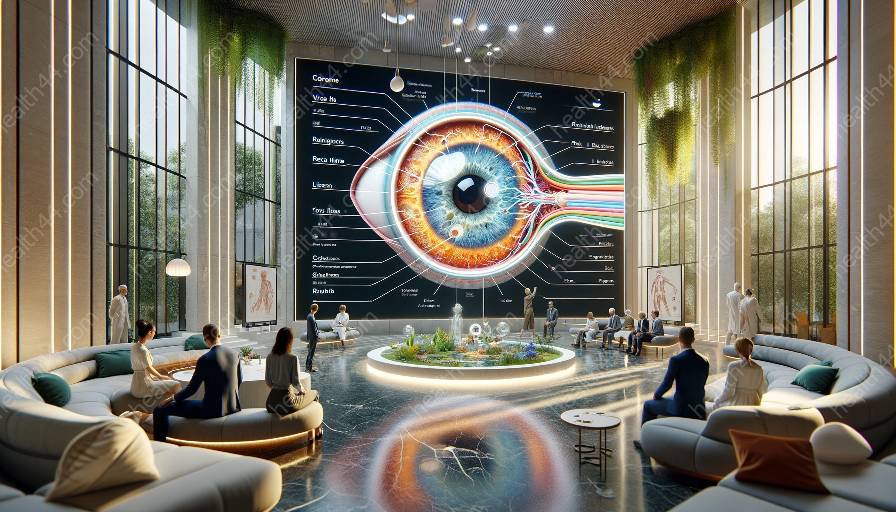Visual impairment can significantly impact an individual's daily life, making tasks such as reading, writing, and navigating the environment challenging. The use of visual aids and assistive devices plays a crucial role in improving the quality of life for individuals with low vision. When considering visual aids and assistive devices for low vision, understanding their compatibility with eye anatomy and their role in vision rehabilitation is essential. This topic cluster will explore the diverse range of visual aids and assistive devices available for low vision, their compatibility with eye anatomy, and how they contribute to vision rehabilitation.
Understanding Low Vision
Low vision is a significant visual impairment that cannot be fully corrected with glasses, contact lenses, medication, or surgery. It can result from various eye conditions, such as macular degeneration, diabetic retinopathy, glaucoma, and retinitis pigmentosa. Individuals with low vision experience challenges in acuity, contrast sensitivity, field of vision, and other visual functions. This can have profound effects on their independence and ability to engage in daily activities.
Eye Anatomy and Low Vision
Understanding eye anatomy is crucial in comprehending how visual aids and assistive devices can support individuals with low vision. The eye is a complex organ consisting of the cornea, iris, lens, retina, and optic nerve, all of which play a vital role in the visual process. When certain parts of the eye are affected by conditions causing low vision, it can lead to impairments in visual perception and processing. Visual aids and assistive devices are designed to complement the remaining visual functions and enhance the residual vision to facilitate better function and independence.
Vision Rehabilitation
Vision rehabilitation is a multidisciplinary approach aimed at maximizing the remaining vision of individuals with low vision and promoting their independence. It involves the use of visual aids, assistive devices, orientation and mobility training, and adaptive techniques to help individuals with low vision adapt to their environment and perform daily activities. Visual aids and assistive devices are integral components of vision rehabilitation, as they can improve visual acuity, enhance contrast, and expand the field of vision, thus enabling individuals to accomplish tasks more effectively.
Types of Visual Aids for Low Vision
Visual aids for low vision encompass a wide range of devices designed to support various visual tasks. Some common types of visual aids include:
- Magnifiers: Magnifiers are optical devices that enlarge images, text, or objects, making them easier to see for individuals with low vision. They come in various forms, including handheld magnifiers, stand magnifiers, and electronic magnifiers with adjustable magnification and contrast settings.
- Telescopic lenses: Telescopic lenses are used to enhance distance vision for individuals with low vision, allowing them to see objects and signs from a greater distance.
- Video magnifiers: Video magnifiers consist of a camera and display screen that magnify printed material, photos, and objects, enabling individuals with low vision to view them with enhanced clarity and contrast.
- Prism glasses: Prism glasses are designed to expand the field of vision and enhance peripheral awareness for individuals with low vision, allowing them to see objects and obstacles in their environment more effectively.
- Electronic aids: Electronic aids, such as tablet-based apps and wearable devices, provide various features, including text-to-speech, contrast enhancement, and image magnification, to assist individuals with low vision in reading, writing, and navigating their surroundings.
Assistive Devices for Low Vision
In addition to visual aids, assistive devices are essential for individuals with low vision to perform everyday tasks with greater ease and independence. Some examples of assistive devices include:
- Audio devices: Audio devices, such as talking watches, clocks, and smartphones with voice commands, provide auditory cues and information, allowing individuals with low vision to access time, notifications, and communication more effectively.
- Large print and tactile materials: Large print books, tactile markings, and audio-tactile maps are essential for individuals with low vision to access information, read and navigate their surroundings independently.
- Adaptive lighting: Adaptive lighting solutions, including adjustable lamps and task lighting, help individuals with low vision in creating optimal contrast and reducing glare in their environment.
- Orientation and mobility aids: Canes, guide dogs, and tactile paving are vital for individuals with low vision to navigate and move around safely in various environments, enhancing their independence and confidence.
Enhancing Vision Rehabilitation with Visual Aids and Assistive Devices
Visual aids and assistive devices play a significant role in enhancing vision rehabilitation for individuals with low vision. They provide practical solutions to address the specific visual challenges faced by individuals with low vision, enabling them to engage in various activities and improve their overall quality of life. By understanding the compatibility of visual aids and assistive devices with eye anatomy and their contributions to vision rehabilitation, eye care professionals, rehabilitation specialists, and individuals with low vision can make informed decisions regarding the selection and use of these devices.
Conclusion
Visual aids and assistive devices for low vision are instrumental in overcoming the challenges associated with visual impairment. By leveraging the benefits of these devices and understanding their compatibility with eye anatomy, individuals with low vision can enhance their visual function, independence, and overall well-being. Through comprehensive vision rehabilitation that incorporates visual aids, assistive devices, and adaptive techniques, individuals with low vision can lead fulfilling and productive lives, effectively managing the impact of their visual impairment.





















